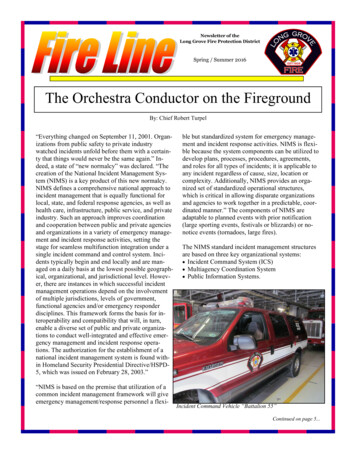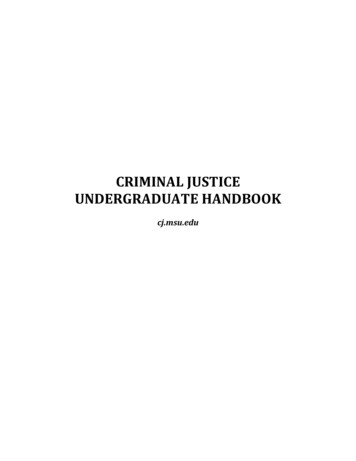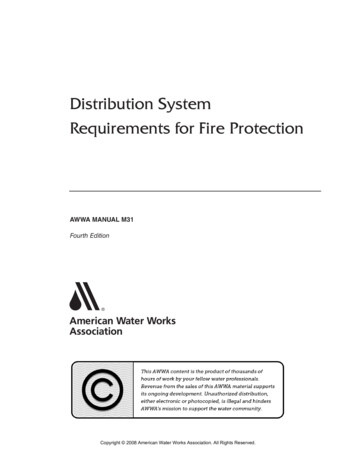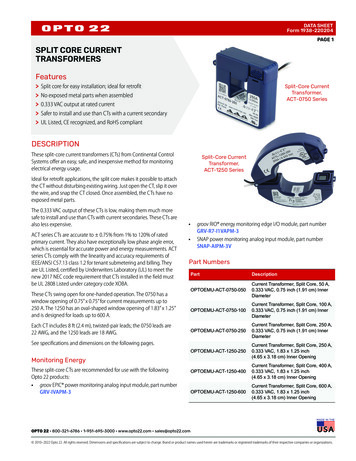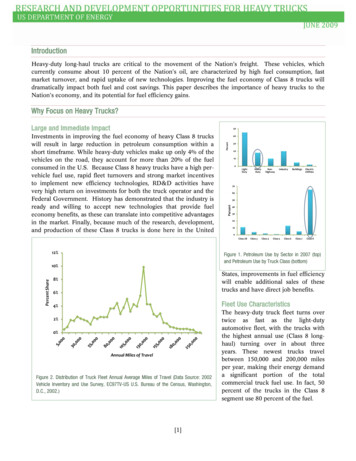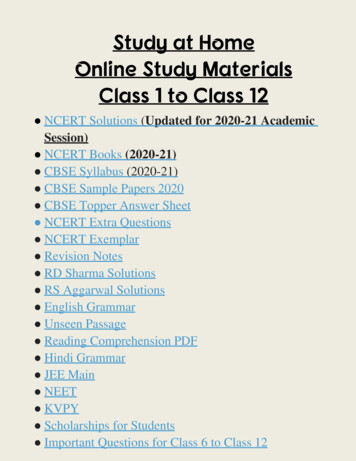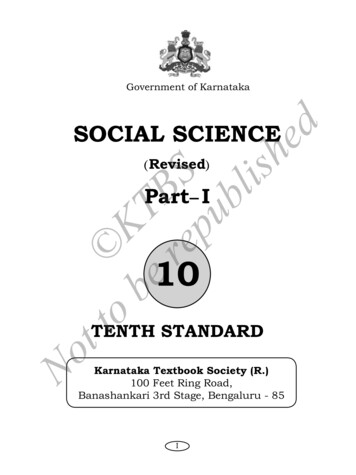
Transcription
Government of KarnatakaKbe TBre Spublis(Revised)hedSOCIAL SCIENCE10o Part-INottTENTH STANDARDKarnataka Textbook Society (R.)100 Feet Ring Road,Banashankari 3rd Stage, Bengaluru - 85I
PREFACEKbe TBre SpublishedThe Textbook Society, Karnataka has been engaged in producing new textbooksaccording to the new syllabi which in turn are designed on NCF – 2005 since June2010. Textbooks are prepared in 12 languages; seven of them serve as the media ofinstruction. From standard 1 to 4 there is the EVS, mathematics and 5th to 10th thereare three core subjects namely mathematics, science and social science.NCF – 2005 has a number of special features and they are: connecting knowledge to life activities learning to shift from rote methods enriching the curriculum beyond textbooks learning experiences for the construction of knowledge making examinations flexible and integrating them with classroom experiences caring concerns within the democratic policy of the country making education relevant to the present and future needs. softening the subject boundaries- integrated knowledge and the joy of learning. the child is the constructor of knowledgeThe new books are produced based on three fundamental approaches namely.Constructive approach, Spiral Approach and Integrated approach The learner is encouraged to think, engage in activities, master skills andcompetencies. The materials presented in these books are integrated with values. Thenew books are not examination oriented in their nature. On the other hand they helpthe learner in the all round development of his/her personality, thus help him/herbecome a healthy member of a healthy society and a productive citizen of this greatcountry, India.ttoIn Social science especially in standard 5 the first chapter deals with the historical,geographical, cultural and local study of the division in which learners live. Chapterson sociology, business studies and commerce are introduced in standard VIII as perthe guidelines of NCF-2005. A lot of additional information is given through boxitems. Learners are encouraged to work towards construction of knowledge throughassignments and projects. Learning load of memorizing dates has been reduced to theminimum. Life values have been integrated with content of each chapter.NoThe Textbook Society expresses grateful thanks to the chairpersons, writers,scrutinisers, artists, staff of DIETs and CTEs and the members of the Editorial Boardand printers in helping the Text Book Society in producing these textbooks.Nagendra KumarManaging DirectorKarnataka Textbook SocietyÀBengaluru, KarnatakaProf. G. S. MudambadithayaCoordinator, Curriculum Revisionand Textbook PreparationKarnataka Textbook SocietyBengaluru, KarnatakaII
Chairpersons’ NotehedA demand for the change of curriculum, syllabi and textbooks hasbeen heard from parents at every internal of five years. The Governmentof Karnataka has accepted the demand favourably and revised itsCurriculum (KCF 2007) and syllabi in all subjects. As a result of ittextbooks are being prepared in various subjects and the result is thisSocial Science book for standard IX. It has been designed and preparedaccording to the changed situations in various curricular areas to enablethe students to construct knowledge through activities. There are sixsubject areas namely, History, Political Science, Geography, Economics,Sociology and Business Studies. Kbe TBre SpublisThe textbook has been prepared keeping in mind the changing situationsin rural and urban scenario and at the same time providing opportunitiesfor creativity among learners. A large number of activities and projectworks have been designed for the purpose. These are designed based onthe fact that we live in a world of competition where acquiring knowledgehas become the need of the day. The matter has been presented in asimple style and technical words have been glossed. That does not meanthat are have succeeded fully in our endeavour though we have followedthe basic principles enunciated in NCF 2005.We express our grateful thanks to all those who gave us concretesuggestions at every stage of preparation of the book. We are grateful tothe writers, the scrutiny committee members and coordinatorProf. G S Mudambadithaya who has been striving hard in planning andbringing out textbooks of very high standard in all subjects. We expressour sincere thanks to the Managing Director, Deputy Director and thecoordinator of Social Science book. I also place on record my indebtednessto the Vice Chancellor, Registrar and other colleagues of the University ofTumakuru for their encouragement and guidance.Dr. M. Kotresh,ChairpersonsA.S. DikshitIII
Textbook CommitteeNotto Kbe TBre SpublishedChairpersons :Dr. M. Kotresh, Associate Professor, Department of Studies and Research in History andArchaeology, Tumakuru University, Tumakuru.Sri A.S. Dikshit, Retd. Principal, Vani Education Centre, Basaveshwaranagar, Bengaluru.Members :Dr. Basavaraja N. Akki, Associate Professor, Government First Grade College, Alnavara,Dharwad Tq.Sri N. Satyaprakash, Head Master, Vidyavardhaka Sangha High School, Ist Block, Rajajinagar,Bengaluru - 10.Sri T. Ningaiah, Associate Professor Govt. First grade college, Gubbi, Tumakuru Distrist.Sri B.K. Vasuki, Asst. Master, Vivekananda Trible Residential High School, B.R. Hills,Chamarajanagar District.Sri B. Hanumantharao, Lecturer, Govt. Pre-University College, Chikkaballapura.Sri Kumaraswamy, Principal, Vidyavahini Pre-University College, Tumakuru.Sri S.H. Kurakundi, Drawing Teacher, Government High School, Masanagi, Byadagi Tq.,Haveri District.Scrutinisers :Dr. Rajram Hegde, Professor, Department of History, Kuvempu University, Shankaraghatta,Shivamogga.Prof. T.D. Devegowda, Professor, Department of Political Science, Dean (Study Centeras)K.S.O.U. Mysuru.Dr. Shoukath Azem, Professor, Depatment of Sociology, Karntaka University, Dharwad.Prof. P. Mallppa, Retd. Professor, Department of Geography, J.S.S. College, Mysuru.Dr. S.R. Keshava, Faculty, Department of Economics, Bengaluru University, Bengaluru.Dr. K.R. Srilakshmi, Associate Professor, Department of Commerce, Government First gradecollege, 6th Block, Jayanagar, Yadiyur, Bengaluru.Editorial Board :Dr. M.V. Srinivas, Retd. Professor, Department of History, Mysore University, Mysuru.Dr. R.L.M. Patil, Retd. Professor, Department of Political Science, Bengaluru University,Bengaluru.Dr. Eshwarappa, Professor, Department of Geography, Bengaluru University, Bengaluru.Translaters :Prof. Geetha Srinivasan, 329/1, Ist Cross, 23rd Main, Sarakhikere Village, 5th Phase, J.P.Nagar, Bengaluru-78.Smt D.R. Renuka, Assistant Professor, Government First Grade College, B.H. Road, Tumakuru.Sri N. Satyaprakash, Head Master, Vidyavardhaka Sangha High School, Ist Block, Rajajinagar,Bengaluru - 10.Chief Co-ordinator :Prof. G.S. Mudambadithaya, Co-ordinator, Curriculum Revision and Textbook Preparation,KTBS, Bengaluru.Chief Advisers :Sri Nagendra Kumar, Managing Director, KTBS, Bengaluru-85Smt. Nagamani, Deputy Director, KTBS, Bengaluru-85Programme Co-ordinator :Sri. A.T. Rangadasappa, Senior Assistant Director, KTBS, Bengaluru-85IV
About the Revision of TextbookshedHonourable Chief Minister Sri Siddaramaiah who is also the FinanceMinister of Karnataka, in his response to the public opinion about thenew textbooks from standard I to X, announced, in his 2014-15 budgetspeech of constituting an expert-committee, to look into the matter. Healso spoke of the basic expectations there in, which the textbook expertsshould follow: “ The textbooks should aim at inculcating social equality,moral values, development of personality, scientific temper, criticalacumen, secularism and the sense of national commitment”, he said.Kbe TBre SpublisLater, for the revision of the textbooks from class I to X, theDepartment of Education constituted twenty seven committees andpassed an order on 24-11-2014. The committees so constituted weresubject and class-wise and were in accordance with the standardsprescribed. Teachers who are experts in matters of subjects andsyllabi were in the committees. There were already many complaints, and analysis about thetextbooks. So, a freehand was given in the order dated 24-11-2014 to theresponsible committees to examine and review text and even to preparenew text and revise if necessary. Eventually, a new order was passedon 19-9-2015 which also gave freedom even to re-write the textbooksif necessary. In the same order, it was said that the completely revisedtextbooks could be put to force from 2017-18 instead of 2016-17.NottoMany self inspired individuals and institutions, listing out thewrong information and mistakes there in the text, had sent themto the Education Minister and to the Textbook Society. They wererectified. Before rectification we had exchanged ideas by arrangingdebates. Discussions had taken place with Primary and SecondaryEducation Teachers’ Associations. Questionnaires were administeredamong teachers to pool up opinions. Separate meeting were heldwith teachers, subject inspectors and DIET Principals. Analyticalopinions had been collected. To the subject experts of science, socialscience, mathematics and languages, textbooks were sent in advanceand later meeting were held for discussions. Women associationsand science related organistation were also invited for discussions.Thus, on the basis of all inputs received from various sources, thetextbooks have been revised where ever necessary.V
dAnother very important aspect has to be shared here. We constitutedthree expert committees. They were constituted to make suggestions aftermaking a comparative study of the texts of science, mathematics and socialscience subjects of central schools (NCERT), along with state textbooks.Thus, the state textbooks have been enriched basing on the comparativeanalysis and suggestions made by the experts. The state textbooks havebeen guarded not to go lower in standards than the textbooks of centralschools. Besides, these textbooks have been examined along side withthe textbooks of Andhra Pradesh, Kerala, Tamil Nadu and Maharashtrastates.Kbe TBre SpublisheAnother clarification has to be given here. Whatever we have donein the committees is only revision, it is not the total preparation of thetextbooks. Therefore, the structure of the already prepared textbookshave in no way been affected or distorted. They have only been revisedin the background of gender equality, regional representation, nationalintegrity, equality and social harmony. While doing so, the curriculumframes of both central and state have not been transgressed. Besides,the aspirations of the constitution are incorporated carefully. Further, thereviews of the committees were once given to higher expert committees forexamination and their opinions have been inculcated into the textbooks.tto Finally, we express our grateful thanks to those who strived in allthose 27 committees with complete dedication and also to those whoserved in higher committees and experts of revised text also. At the sametime, we thank all the supervising officers of the Textbook Society whosincerely worked hard in forming the committees and managed to see thetask reach its logical completion. We thank all the members of the staffwho co-operated in this venture. Our thanks are also due to the subjectexperts and to the associations who gave valuable suggestions.NarasimhaiahManaging DirectorKarnataka Textbook Society (R)Bengaluru.NoProf. Baraguru RamachandrappaChairman-in-ChiefState Textbook Revision CommitteesKarnataka Textbook Society (R)Bengaluru.VI
Text Book Revision CommitteeCHAIRMAN IN CHIEFProf. Baraguru Ramachandrappa, Chairman, State Textbook Revision Committee,K.T.B.S. Bengaluru.CHAIRPERSONDr. Aswathanarayana, Professor, Department of History, University of Mysore, Mysuru. Kbe TBre SpublishedMEMBERSDr. Aswathanarayana, Professor, Department of History, Bangalore University,Bengaluru-56.Dr. J. Somashekar, Professor, Department of Political Science, VijayanagarSri Krishnadevaraya University, Ballari.Dr. H.D. Prashant, Professor, Department of Developmental Studies, Kannada University,Hampi, Vidyaranya.Dr. S.T. Bagalkoti, Professor, Department of Studies in Economics, Karnatak University,Dharwad.Prof. P. Mallappa, Professor (Retd.), Department of Geography, J.S.S. College, Mysuru.Dr. B. Shekhar, Professor, Department of Studies and Research in Commerce, TumkurUniversity, Tumakuru.Sri A.S. Dikshit, Principal (Retd.), Vani Education Centre, Basaveswaranagar,Bengaluru-79.Sri Iaranna M. Ambi, Asst. Teacher, G.H.S. Tadakodu, Dharwad Taluk and District.Sri D.N. Venkatesh, Drawing Teacher, G.H.S. Uramarkasalagere, Mandya Taluk andDistrict.ttoSCRUTINIZERSSri. Ashok V.Shettar, Associate Professor, Deparment of History and Archaeology,Karnatak Univesity, Dharwad.Dr. M.S. Talawar, Professor (Retd.), Deparment of Studies in Education, BangaloreUniversity, Bengaluru.Dr. Dhasharath Naik, Professor, Department of Economics, Gulbarga University,Kalaburagi.Dr. Haseen Taj, Professor, Deparment of Studies in Education, Bangalore University,Bengaluru.NoTRANSLATORSSri. Sadanand .R, Lecturer, G.P.U.C for Girls, Hunsuru Tq. Mysuru District.CHIEF ADVISORSri. Narasimhaiah, Managing Director, Karnataka Text Book Society, Bengaluru- 85.Smt. Nagamani, C., Deputy Director, Karnataka Text Book Society, Bengaluru -85.PROGRAMME COORDINATORSri Siddaiah T.G, Senior Asst. Director, Karnataka Text Book Society, Bengaluru -85.VII
INDEXSLNO.HISTORYADVENT OF EUROPEANS TO INDIATHE EXTENSION OF THE BRITISH RULEOPPOSITION TO BRITISH RULE IN KARNATAKASOCIAL AND RELIGIOUS REFORMATION MOVEMENTSTHE FIRST WAR OF INDIAN INDEPENDENCE (1857)Kbe TBre SpublisPOLITICAL SCIENCE1.2.3.dTHE IMPACT OF BRITISH RULE IN INDIA11117314557he1.2.3.4.5.6.PAGENO.TITLETHE PROBLEMS OF INDIA AND THEIR SOLUTIONSINDIAN FOREIGN POLICYINDIA’S RELATIONSHIP WITH OTHER COUNTRIES627075SOCIOLOGYLABOURINDIAN POSITION AND EXTENTIONINDIAN PHYSIOGRAPHYINDIAN CLIMATEoINDIAN SOILSINDIAN FOREST RESOURCESINDIAN WATER RESOURCESINDIAN LAND RESOURCESNo1.2.7986GEOGRAPHYtt1.2.3.4.5.6.7.SOCIAL STRATIFICATION URAL DEVELOPMENTBUSINESS STUDIES1.2.152160BANK TRANSACTIONSENTREPRENEURSHIPVIII
HISTORYUNIT – IADVENT OF EUROPEANS TO INDIAKbe TBre SpublishedIn this unit you learn: The trade and commerce relationship India had with Europeans The arrival of Europeans to India for trade The Carnatic wars in the backdrop of European politicaldevelopments. Battle of Plassey, Battle of Buxar and Dual-Government system The British policy of aggressionNotto There were trade and commerce relationship between India andEurope since ancient times. There was great demand for Indian spiceslike Pepper, Cardamom, Ginger and many other spices in Europe. Thetrade relationship continued between India, Europe and other Asiancountries even during middle ages. The Arab merchants carried the Asianmerchandise into Constantinople of Eastern Roman (Byzantium) Empire.Italian merchants would buy these goods and then sell in Europeancountries. Like this, Constantinople was the center of internationalbusiness and considered as the ‘Gate of European Trade’. While Arabmerchants had gained monopoly over the trade in Asian countries, Italiantraders had gained monopoly over trade in Europe. The merchandise fromAsia had brought good profits to Italian merchants.The fall of Constantinople: The trade and commerce between Asiaand Europe was taking place through the city of Constantinople. In 1453,the Ottoman Turks captured the city of Constantinople. As a result, all thetrade routes connecting the city of Constantinople came under the controlof Turks. The Turks started levying too many taxes on the goods passingthrough these routes. As a result, the merchants felt that the trade wasnot profitable. Meanwhile, Spain and Portugal were attempting to breakthe monopoly of Italian traders. They started encouraging courageoussailors to find a sea route to India. The invention of Compass, Astrolabes,and Gunpowder provided further impetus to this venture.A new sea route to India: Vasco da Gama, the Portuguese sailorwho left Lisbon and reached Kappadu near Calicut on the East coast ofIndia in 1498. By this, he was successful in discovering a new sea route1
to India. This route continued to be the route of trade between India andEurope for many years. Like this Portuguese were the first to re-establishtrade between India and Europe.Kbe TBre SpublishedKnow this:In 1869, a huge canal was built in Egypt to connect the Red Sea andMediterranean Sea and it is called Suez Canal. Until the building of Suezcanal, the sea route discovered by Vasco da Gama was the route usedfor the trade between India and Europe. The ships had to pass the Capeof Good Hope, the southernmost tip of Africa to reach India. The distancebetween Mumbai and London through Cape of Good Hope is 10,800nautical miles (01 nautical mile 1.85 KMS), it is only 6,200 nauticalmiles through Suez canal. The journey is reduced to half of the distance.European Trade Companies:With success of Portuguese, many Dutch, French and Englisharrived at India for trade. This development not only changed the historyof India, it also changed the history of European countries.tto Portuguese: Portuguese were the first to arrive at India for the tradeand were also the last to leave India on the sea route. After Vasco daGama, Francisco de Almeida arrived in India as the Viceroy of Portuguese.He implemented ‘Blue Water Policy’ in order to establish the supremacyover the Sea instead of supremacy over lands. Alfonso de Albuquerque,who came after Almeida, is considered as the real founder of PortugueseEmpire in India. He waged a battle against the Sultan of Bijapur in1510 and won Goa. Goa became the administrative centre of Portugueseadministration in India. The Portuguese had absolute monopoly overtrade with India for almost a century and their power declined with thearrival of English and French in India.NoDutch: Dutch are from Holland or Netherlands. They establishedUnited East India Company in 1602 with the aim of doing businesswith eastern countries and entered countries like India, Java, Sumatra,Indonesia and spices rich islands. They established warehouses in Surat,Broach, Kambe, Kochin, Nagapatanim, Masulipatanam and Chinsor andother places in India. With this they broke the monopoly of Portuguese inIndia. Later, unable to face competition from English and French, Dutchlimited themselves to Spice rich Islands.2
Know this:The Warehouses were the places of storing merchandise. Huge wallswere built around these warehouses to provide protection. Kbe TBre SpublishedEnglish: In 1600, December 31, Queen Elizabeth issued a royalcharter authorizing East India Company to trade with Eastern Countriesfor fifteen years. The company started the business formally in 1613.The Mughal Emperor Jahangir issued a royal permission to English toestablish their first warehouse of factory at Surat. In 1617, Sir Thomas Roearrived at the court of Jahangir as the royal ambassador from the courtof James I. He sought permission from Jahangir to establish factoriesin other places of Mughal Empire. English established factories in Agra,Ahamadabad and Broach. In 1639, English took Madras from the King ofChandragiri and established a strong fort named St. George Fort. Later,Charles II, the Prince of England, gave Bombay as an annual rent often pounds a year to East India Company in 1668. In 1690, the Englishpurchased three villages namely Sutanauti, Kalikata and Govindapura onthe banks of Hugli River and built Fort William. The city of Calcutta grewaround this fort. By 17th century, the English had established Bombay,Madras and Calcutta as the centers of their Presidencies. By the laterpart of Eighteenth century, the English made Calcutta as their capitalcity. They implemented their own Civil and Criminal Procedure Codes inthe areas that were under their control.Notto4. French: French East India Company started as a government ownedcompany in 1664. It started its first factory in Surat in the year 1668.Later they established its factories in Machalipatanam, Chandranagara,Mahe, Karaikallu, Cossimbazar, Balasur. In 1674, the French tookValikandapuram from a local Muslim official and developed it as a majortrade center. That center is Puducheri or Pondichery. Dupleix, whoarrived in Pondicherry as the Governor General of French had the highambitions of establishing French as the major power in South India. Thisambition led to Carnatic wars with the English.The Competition between English and FrenchThe Portuguese and Dutch had withdrawn from India unable towithstand the competition from French and English by 18th century.Finally, French and English resorted to show strength in order to establishtheir political supremacy over India. Meanwhile, political volatility arousedin the regions of Hyderabad and Carnatic (Eastern part of Tamil Nadu)3
o Kbe TBre Spublishedand both the English and French tried to exploit the situation in theirfavour. This led to three Carnatic Wars.NottKEYB - BritishF - FrenchD - DutchP - Portuguese4
Know thisHyderabad Kingdom was established in 1724 by AsafJha. Hisfeudatory ruler Dost Ali who was ruling Carnatic region was not loyalto him. The Marathas killed Dost Ali in 1740 and looted Carnatic andimprisoned his Son-in-law Chandasheb in Sathara. AsafJha namedAnwaruddin as the Nawab of Carnatic in the place of Dost Ali.First Carnatic War (1746-48):Kbe TBre SpublishedOn the request of Dupleix, La Bourdonnais, a French military leaderfrom Mauritius invaded Madras and captured it. This forced the helplessBritish to request the help of Anwaruddin, the Nawab of Carnatic forsupport. The army sent by Anwaruddin failed to defeat the French atMadras. Finally, La Bourdonnais took money from the English andreturned Madras and went back to Mauritius. This enraged Dupleix andattempted to take Madras but failed in it. Finally, this war ended witha treaty in Europe between France and England called‘Treaty of Aix-laChapelle‘.Notto Know this:The Nizam of Hyderabad, AsafJha died in 1748. A tussle started betweenhis son Nasir Jung and his daughter’s son Mujaffar Jung for the throne. Onthe other hand, a fight had broken out between Chandasaheb(who wasreleased from the Maratha prison) and Anwaruddin in Carnatic. Frenchextended their support to Mujaffar Jung in Hyderbad and Chandasahebin Cranatic. The English extended their supported Nasir Jung andAnwaurddin.IN 1749, the combined forces of French, Chandasaheb and MujaffarJung defeated Anwaurddin and killed him in Ambur battle. As a resultChandsaheb became the ruler of Carnatic. Mahammad Ali, the son ofAnwaruddin, stayed at Thiruchanapalli with the help of English. InHyderabad, Mujaffar Jung became the Nizam by killing Nasir Jung with thehelp of French and Chandasaheb. He got killed after a few days. The Frenchmade Salabath Jung, another son of Asaf Jha as the Nizam of Hyderbad.Second Carnatic War (1749-1754):In the changed circumstances, French made Salabath Jung,another son of AsafJha as the Nizam of Hyderabad. An officer named Bussiwas stationed in Hyderabad for his protection by French. In Carnatic5
Chandasaheb was the Nawab with the help of French. Robert Clive ofEast India Company attacked Arcot, the capital city of Carnatic anddefeated Chandsaheb. Chandsaheb was imprisoned and later killed inthis war. In the place of Chandsaheb, the English named Mahammad Ali,the son of Anwaruddin, as the Nawab of Carnatic. The second Carnaticwar ended with the Treaty of Pondicherry. French recalled Dupleix. Thiswar brought laurels to English, while French suffered a political setback.Kbe TBre SpublishedThird Carnatic War (1756-1763):Comte de Lally of French attempted to besiege Wandiwash in 1760.In this decisive battle Sir Eyre Coote of the English army defeated theFrench and imprisoned Bussi. Lally escaped and hide in Pondicherry.Finally, Eyre Coote attacked Pondicherry and Lally had to surrenderunconditionally in 1761.French had to lose all their bases in India due to Carnatic wars. Inspite of this, as per the ‘Treaty of Paris’ in 1763, Pondicherry was returnedto French. With these developments, French lost their importance inIndia. Like this, English by defeating all their rivals, started consolidatingtheir power over the Southern India. Know this:NottoRobert Clive: Robert Clive, who laid the firm foundation of the BritishPower in India, had joined the East India Company as clerk. He played adecisive role in Carnatic wars, particularly in the siege of Arcot and playeda prominent role in the British victory. He was successful in establishingthe British rule over South India and was instrumental in Bengal victoryalso. After the Battle of Plassey in 1757, he gained control over the Nawabof Bengal also. Clive amassed immense wealth in all these ventures andhelped the East India Company to earn more profit. Clive returned toEngland with immense wealth rich and became the Member of Parliament.With the return of Clive to England, the East India Company started facinglosses in its business. Even though, there were many allegations againstClive, the British government had to resend Clive to India to save thecompany and also save the face of the country.6
Kbe TBre SpublishedThe British won the Buxar battle and earned back its respect again. Clivewas successful in securing the Dewani rights for the British over Bengal,Bihar and Odisha regions. This brought more wealth to Robert Clive and toEast India Company as well.Dupleix:Dupleix was named the Governor General of French regions in Indiain 1742. He dreamt of achieving French harmony over India and enteredinto treaties with the local kings. Hyder Ali was also trained in the armyof locals raised by Dupleix. The British considered Dupleix as a formidablechallenge to them. Hence, we notice clashes over between the French andthe British to gain supremacy over Carnatic and Deccan Plateau. Dupleixplayed an important role in the First Carnatic War in 1746. The rivalrybetween the French and the British continued till 1754. Later, Frenchgovernment recalled Dupleix as it wanted peace.tto The British Rule in IndiaAfter gaining political control over South India, the British tried togain control over rich Bengal province in the later part of 18th century.The Bengal province had achieved tremendous growth in the areaof agriculture, commerce and industry. The East India Company wasmaking considerable profit from this province. The Dastakths (Licence)issued by the Mughal ruler Faruk Shiara were the main reasons for this.But, these Dastakths that were limited to the company transactions weremisused by the individual officers of the company too. This resulted inhuge loss to the Bengal government. Hence, all Nawabs from MurashidAli Khan to Ali Wardhikhan were opposing such misuses. Later this ledto confrontation between the Nawabs and the company. This resultedin two crucial wars which charted a decisive course to Indian history.Plassey and Buxar were those two wars.NoKnow this:Dastakath-a license that can ensure anyone to import and export withoutpaying any tax and transport goods anywhere.Battle of Plassey (1757): Aliwardi Khan, the Nawab of Bengal diedin 1756. His grandson Siraj-ud-Daula came to throne. The Plassey Battletook place between the young Nawab Siraj-ud-Daula and the British in1757.7
Kbe TBre SpublishedReasons:1. Misuse of Dastakaths: Siraj-ud-Daula was furious that theDastakaths were misused by the officials of the company incurring lossesto the government treasury.2. Mending of the fort without permission: The British repairedthe fort of Calcutta and placed canons in them. This further angeredSiraj-ud-Daula and he ordered the removal of canons from the court. TheBritish refused to do this angering the Nawab further.3. Black Room Tragedy: Siraj-ud-Daula conquered the Fort Willaimeasily and imprisoned some of the British. He imprisoned 146 Englishmenin a small room in the fort, of which 123 died. This is called as the BlackRoom Tragedy. This enraged Robert Clive and arrived in Bengal with alarge army. Robert Clive attracted rich locals like Manikchand, Omichand,Jagath Seth and others towards him. He was successful in convincingMir Jaffar, the military head of Siraj-ud-Daula to stay neutral in thebattle by offering him the post of Nawab of Bengal. Encouraged by allthese developments, Robert Clive declared war against Siraj-ud-Daula.Everything went according to the plan of Clive. Siraj-ud-Daula who triedto escape from the battle field was captured and killed.NottoOutcome:1. This war brought out the immorality, lack of unity among theIndians and the greed of Indian businessmen.2. Mir Jaffar became the Nawab of Bengal.3. The company gained exclusive rights to do business in Bengal.4. Mir Jaffar had to a pay rupees seventeen corner and seventylakh to as a relief to Sirja-ud-Dulah’s attack on the Fort William.In nutshell, Mir Jaffar became continuous victim of the companyand its employees. Even though the treasury went bankrupt due to thisgreedy nature, the greediness of the company and its officials were neversatisfied. The British projected Mir Jaffar as an inefficient Nawab andbrought in his nephew Mir Qasim as the new Nawab.8
Outcomes:Kbe TBre SpublishedBattle of Buxar (1764): Mir Qasim was an efficient administrator.In the beginning he remained loyal to the company. He paid two lakhpounds to the company and gave away few places to it. Shortly, hedeclared himself as an independent King. After verifying the misuse ofDastakaths, he declared that the business is duty free in Bengal. As aresult, the Indians competed against British in all spheres of business.As a result, the British trade suffered considerably. This was enough forthe British to oppose the Nawab. They brought i
In Social science especially in standard 5 the first chapter deals with the historical, geographical, cultural and local study of the division in which learners live. Chapters on sociology, business studies and commerce are introduced in standard VIII as per the guidelines of NCF-2005. A
